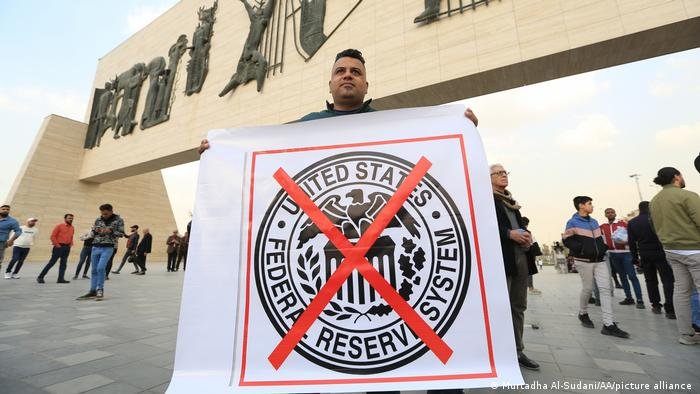Experts say that the war in Ukraine has raised fears of the use of the currency as a political weapon by the US, but they point out that the dominance of the dollar is also due to the facilities it offers. last year, when the Iraqi government announced a ban on doing business in dollars.
If they want to buy something of high value, Iraqis usually use dollars. Because of the constant devaluation of their own currency, the dinar, they would need several bags full of dinars to buy a car or a house. The necessary dollars already fit in a briefcase.
For decades, the dollar has been the best currency to have in the Middle East for those who don’t have dirhams, dinars, rials or pounds readily available. But that may be starting to change. In recent months, several politicians in the region have made statements in which they suggest that the dominance of the dollar may be at an end.
In Iraq, US officials are making it difficult for dollars to flow in, apparently out of fear that too much US money is being smuggled into Iran, which is under economic sanctions but is tacitly supported by Iraqi politicians. The lack of dollars has led to fluctuations in the value of the Iraqi dinar, which is pegged to the US currency.
This fluctuation led to the ban announced last week. In February, partly because of the lack of US currency, Iraq announced that it would do business with China using the yuan instead of the dollar.
In search of alternatives
Earlier this year, Saudi Arabia’s finance minister declared that his country was also willing to sell oil using other currencies, including the euro and yuan.
The UAE has said it will work with India, using the Indian rupee. Last year, Egypt, which already issued government bonds in yen, announced plans to do the same in yuan.
In addition, several countries in the Middle East, such as Egypt, Saudi Arabia, the United Arab Emirates, Algeria and Bahrain, have announced that they want to join the BRICS (Brazil, Russia, India, China and South Africa).
Russia declared that, at the next meeting, in June, the group will discuss the creation of a kind of single currency for trade between its members.
Since 2021, the UAE has also been part of a pilot project of the Bank for International Settlements (BIS), a kind of central bank of central banks. The project is aimed at digital international payments that can bypass the use of dollars. Other participants are Thailand, Hong Kong and China.
Is this the end of the dollar’s dominance?
These alternatives to the US dollar led to a series of alarming headlines. “Is dollar dominance under threat?” asked the New York Times. “Prepare for a multipolar monetary world,” warned the Financial Times. “Dedollarization is taking place at a rapid pace,” Bloomberg reported.
According to the agency, the dollar corresponds to 58% of official foreign reserves, much less than the 73% of 2001. At the end of the 1970s, the percentage was 85%.
But most experts insist that change is happening at a much slower pace than these headlines suggest. And that certainly goes for the Middle East.
In the Persian Gulf, the dollar dominates
Since the 1970s, oil-producing countries in the Persian Gulf have had a partnership with the United States, whereby the United States provides security and those, such as Saudi Arabia and the United Arab Emirates, export oil. Most countries, with the exception of Kuwait, have pegged their own currencies to the dollar.
“One of the biggest indicators of a serious shift away from the dollar would be the uncoupling of these currencies”, comments researcher Hasan Alhasan, from the International Institute for Strategic Studies, in London. “But that didn’t happen.”
Political scientist Daniel McDowell of Syracuse University in New York says the key words are “statements” and “potentially.”
“Statements are easy, action is harder,” he says. “For oil-producing countries like Saudi Arabia, this type of statement is also a way to get the attention of the United States. Flirting with the Chinese can make American politicians pay more attention to the interests of the Gulf countries.”
McDowell doesn’t rule out the possibility that the dollar’s dominance will one day weaken. “One day, all empires collapse.” But now, “this is mostly symbolic and political talk. Any change will be marginal and slow.”
war in ukraine
There are two main reasons why Middle Eastern countries make threats to use other currencies. The first is the war in Ukraine. For McDowell, sanctions are a fundamental aspect of this debate.
“The more the United States uses the dollar as a foreign policy weapon, the more its adversaries will move their international economic activities to other currencies”, he argues.
“Today there is a lot of Russian money circulating in countries in the Middle East and Asia”, comments Alhasan. “These are basically countries that have chosen not to comply with, or not implement, US or European sanctions.” But if the sanctions on Russia are tightened, turning them into what are called secondary sanctions, these countries will be in a much more difficult situation.
Minor sanctions also punish countries or companies that work with the sanctioned entity. “So governments that fear US sanctions are increasingly thinking about how to move forward, even if they’re not yet ready or interested in making a radical shift away from the dollar,” says McDowell.
bad for business
Alhasan sees a second reason why some Middle Eastern countries want to move away from the dollar. “There is an impression that the US is trying to rewrite the rules of the world oil market to affect Russian interests and that this poses a strategic threat to Saudi Arabia,” he argues.
In March, Saudi Energy Minister Abdulaziz bin Salman said that if any country tries to impose a price cap on Saudi exports, as Russia did, then Saudi Arabia will no longer do business with that country. A day later, the government of Algeria issued a similar statement.
That’s why the shift away from the dollar is likely to continue as long as there are sanctions, argues economist Maria Demertzis of economic think tank Bruegel.
But it won’t be overnight. Even if some countries want to bypass the dollar as their currency, the hardest part will be replacing the clearing infrastructure that the dollar-based system provides, says Demertzis.
“If India wants to sell something to Chile, for example, it will possibly do so in dollars. Not only because it is easier to determine a dollar price, but also because it can use the dollar infrastructure to close the transaction”, explains Demertzis.
Clearing is the act of transferring money from one account to another, and to do that, you need a reliable infrastructure, something the United States has provided for decades.
Creating an alternative has huge legal and governance implications. “For example, does Chile recognize India’s legal framework? Even to get to the point where two central banks can enter into bilateral agreements is a long journey.”
The fact that the US and Europe froze Russian central bank assets held in their jurisdictions also made central banks a weapon and possibly harmed the international financial system, says Demertzis.
In the Middle East, this has translated into “a sense of concern over the unprecedented use by the US and also the EU of trade and international finance as weapons in the context of war with Russia”, concludes Alhasan.
That is why Middle Eastern countries “are preparing for a more multipolar global world, in which they want to be well positioned to act inside and outside the dollarized zones”.
#Middle #East #Rejecting #Dollar








